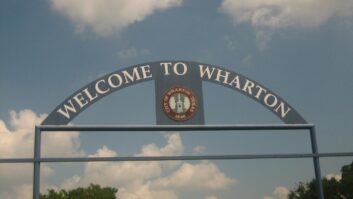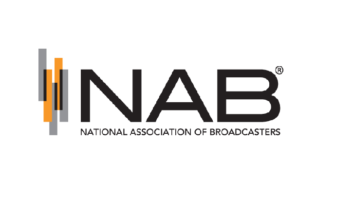
Sandia Crest above Albuquerque, N.M., is one of the nation’s biggest multi-user FM/TV sites. Shown are examples of RF signage at the gate areas. Photo by Scott Fybush. A rulemaking proceeding underway at the FCC could mean more signage around radio facilities and more training for tower workers, but experts believe it’s unlikely to result in any major changes for the way most broadcasters operate.
“It’s really a mass of little corrections and changes,” said Lawrence Behr, chairman of LBA Group Inc., speaking about the FCC Report and Order published in the Federal Registerin June.
The report comes nearly a decade after the commission opened a proceeding in 2003 to investigate proposed changes in its rules concerning “Human Exposure to Radiofrequency Electromagnetic Fields.” That proceeding lingered at the commission until just a few weeks ago, when the FCC issued the R&O along with a Further Notice of Proposed Rulemaking in the original docket (ET Docket 03-137) and a new Notice of Inquiry that opens a fresh docket, ET Docket 13-84.
This split enables the agency to consider two topics. In the original docket, the NPRM will examine how the FCC determines compliance with its existing RF exposure limits, while the new docket will examine whether those limits are still appropriate “in light of more recent developments.” (Some changes, like clarification of existing rules, specifically for RF safety training, become effective Aug. 5.)
While this all sounds like the sort of obscure FCC process that can yield unexpected headaches for stations, Behr said that’s not the case this time around. “For broadcasters, there’s very little here that will have any impact, and in the current revision even less so. There’s virtually nothing here that isn’t a technicality.”
Bob duTreil Jr., principal at the consulting firm duTreil, Lundin and Rackley, said the proceeding hasn’t been on his radar much, saying the FCC’s rule changes mainly “concern the way RF is measured from mobile devices.”
So why should radio engineers be paying attention at all?
If there’s any reason to be concerned, according to experts, it may be the possibility of new rules stemming from that new docket and from the further rulemaking in the original docket. Among issues for which the FCC is seeking public input are transmitter site signage, transient exposure limits and the possibility of “contact current” injuries from construction crews working in close proximity to AM stations.
“Broadcasters have had to have signs already,” says David Maxson, chief executive officer of Isotrope LLC and head of RFSigns.com, which sells those familiar red “DANGER,” orange “WARNING” and yellow “CAUTION” signs.
According to Maxson, “For the first time, though, the FCC is specifying what good practice is and not relying on other agencies.”
LICENSEE RESPONSIBILITY
“There probably will be a little more interactivity between the FCC standards and OSHA,” said Behr, “only to the extent that the rules seem to be heading toward tightening up licensee responsibility.”
The specific proposal on which the FCC seeks comment would use a modified version of IEEE’s standards to specify exactly where “NOTICE,” “CAUTION” and “WARNING” signs should be placed at a transmitter site. The commission also is taking a harder look at the question of “transient” exposure, where members of the general public may be passing through areas of higher RF in areas such as hiking trails that run in proximity to multiple-user mountaintop FM and TV sites.
“We request comment on anticipated costs related to implementing this proposal for clear definition of compliance boundaries, given that most sites already likely comply with these proposed requirements,” the FCC states in the notice. “We intend to allow sufficient time for licensees to inspect each of their sites for compliance if there may be any uncertainty.”
Amateur radio operators may want to pay attention, too; the proposed new rules would take away the blanket exemption that formerly saved ham licensees from having to conduct RF radiation studies. Households where amateur stations operate should be considered under “occupational exposure” standards, which may require signage and education for household members, according to the agency.
The proposed rules have the potential to become expensive for a handful of radio owners whose transmitter sites are in remote areas. The commission notes that in the past, the agency has allowed warning signs to be used without physical barriers in areas that the agency considers “remote.” But the commission seeks comment from stations about whether it should continue to try to determine the “remote” nature of a site as it now does, by considering “evidence of public access, such as litter and trails,” or whether the commission should automatically require “positive access control,” as in fences and gates.
TRAINING
In setting out its new rules, the FCC also is formalizing its expectations for station owners to educate employees and contractors who may be working in areas that exceed general exposure limits.
Among the mass of minor technical changes that take effect on Aug. 5, mainly relating to specific methods of determining RF exposure, the commission is also revising section 1.1310 of its rules for broadcast stations. The new version of those rules now allows for “transient” workers whose jobs may involve occasional entry into high-RF zones to receive warning information verbally, instead of or in addition to the written warnings now mandated.
Behr said his company’s LBA University has been busy helping RF operators understand what they’re now required to do by both OSHA and the FCC.
“There is a huge amount of interest in training,” Behr said, not only from broadcasters but also from wireless operators.
It’s those wireless operators who may feel more of the sting from the FCC’s proposed new rules, as the wireless world has exploded since the original 2003 docket opened. The bulk of the FCC’s work here concerns exposure levels, not only from fixed transmitters but from mobile devices.
As for the new docket being opened by the FCC, it’s mostly a specific inquiry that even the experts on broadcast RF exposure are unlikely to join, according to some observers.
“Our purpose in opening this proceeding is to provide a forum for full and transparent discussion to determine whether any action may be appropriate,” the commission states, but the agency notes that its especially interested in hearing from experts at other federal agencies — and that the information being sought is specialized, having to do with different standards for measuring RF exposure across the human body.
The issue in the new inquiry that may be of the most interest to broadcasters has to do with “contact currents,” the shocks and burns that can zap construction workers who are near large metal objects like cranes and metal roofs in close proximity to AM transmitters. The FCC asks for comment on whether the agency should provide maps showing where those intense fields (10 volts/meter or higher) are present, and whether broadcasters already have access to that information.
Further complicating the matter, the FCC notes, “the AM station may be a long-standing facility, while recent development has generated the construction nearby.” The commission is asking broadcasters to weigh in on whether the station or the developer should bear the cost of mitigating this issue, and whether the FCC is even the appropriate agency to ask the question.
“We’ve been contemplating whether we want to put any comments in and haven’t made a decision whether we want to or not,” said LBA’s Behr. “Some broadcasters may look at this and their attorneys may want to put some stakes in the ground, but I don’t see anything I would particularly suggest.”
For those who do want to file a comment to ET Docket 13-84, the comment period closes Sept. 3, with reply comments due Nov. 1.










